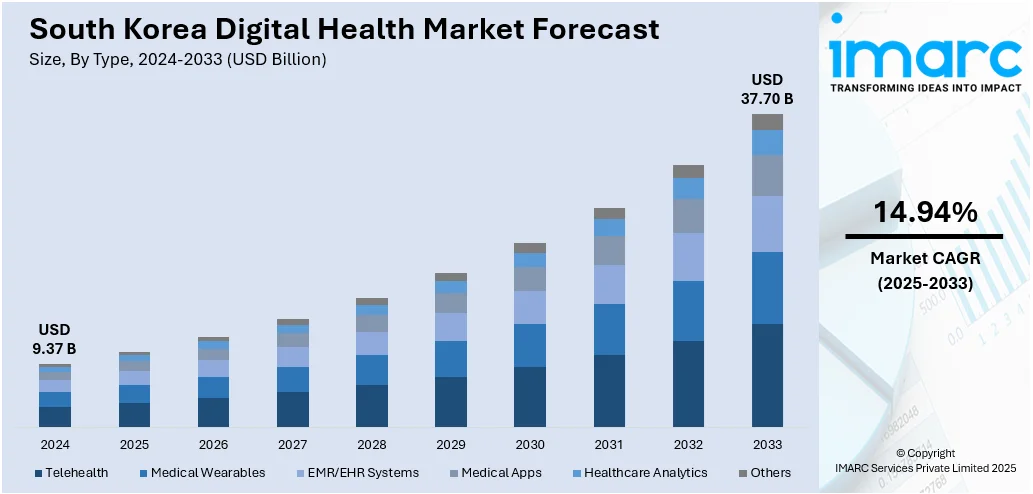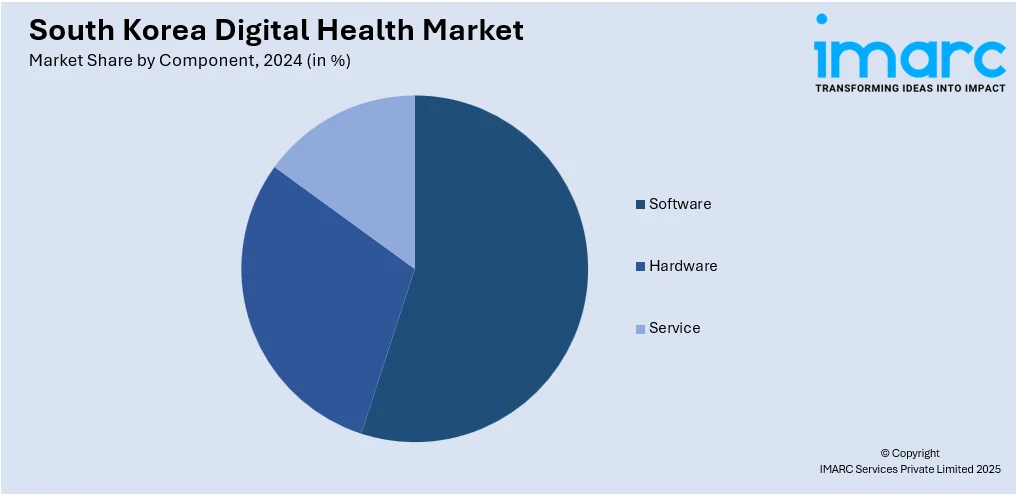
South Korea Digital Health Market Size, Share, Trends and Forecast by Type, Component, and Region, 2025-2033
South Korea Digital Health Market Overview:
The South Korea digital health market size reached USD 9.37 Billion in 2024. Looking forward, the market is expected to reach USD 37.70 Billion by 2033, exhibiting a growth rate (CAGR) of 14.94% during 2025-2033. The market is advancing rapidly, driven by the integration of AI, telemedicine, wearable technologies, and electronic health systems. Strong government backing, robust ICT infrastructure, and growing demand for personalized healthcare are fueling innovation across the ecosystem. These developments are significantly contributing to the expansion of the South Korea digital health market share.
|
Report Attribute
|
Key Statistics
|
|---|---|
|
Base Year
|
2024
|
|
Forecast Years
|
2025-2033
|
|
Historical Years
|
2019-2024
|
| Market Size in 2024 | USD 9.37 Billion |
| Market Forecast in 2033 | USD 37.70 Billion |
| Market Growth Rate 2025-2033 | 14.94% |
South Korea Digital Health Market Trends:
Government Support and Regulatory Advancements
The South Korean government is at the forefront of advancing the digital health ecosystem with favorable polices, regulatory adjustments, and specific funding. Such programs as the “Digital New Deal” are aimed at the implementation of smart technologies within the healthcare sector, appealing to hospitals regarding the use of AI-enabled diagnostics, telemedicine, and cloud-based medical data storage services. Moreover, the changes in the telehealth legislations, particularly the COVID-19 pandemic, have increased the adoption of remote care, obtaining even more acceptance among people and trust from institutions. Such government-sponsored initiatives drive innovation while also simplifying the process of launching businesses in the health-tech market and attracting global companies. Collectively, this regulatory momentum is fostering a more robust, scalable, and patient-centered digital health landscape across South Korea.

To get more information on this market, Request Sample
Technological Infrastructure and AI Integration
South Korea's robust foundation for digital health services is built upon its cutting-edge information and communication technology (ICT) ecosystem, which includes ultra-fast internet connectivity, extensive 5G network coverage, and high smartphone penetration across the population. This environment enables seamless implementation of mobile health apps, remote patient monitoring, and real-time medical data sharing, which is further driving the South Korea digital health market growth. The use of AI is getting absorbed in the processes of diagnostic systems, predictive analytics, and clinical decision support tools, increasing their efficiencies and accuracies. Radiological use of AI has also become quite popular in hospitals and clinics, where their platforms are quickly emerging as powerful imaging, triaging, and chronic disease management tools. Also, the youth is currently tech-savvy, which makes them respond to digital technologies more quickly and easier to use. One of the ultimate factors that pushes the digitalization of healthcare in South Korea forward is a solid digital infrastructure combined with artificial intelligence.
Rising Demand for Personalized and Remote Healthcare
As the population ages and chronic illnesses become more prevalent, there is a growing demand for healthcare solutions that are tailored, accessible, and convenient. South Korean consumers increasingly prefer digital platforms for scheduling consultations, managing health records, and accessing telehealth services. Remote healthcare technologies, including wearable devices and home monitoring systems, are gaining popularity, especially among the elderly and rural populations. These tools allow continuous health tracking and early intervention without the need for hospital visits. Furthermore, digital therapeutics and precision medicine are gaining traction, offering patients data-driven, personalized treatment plans. This demand for individualized care, combined with the convenience of digital delivery models, is significantly boosting the growth of the South Korea digital health market.
South Korea Digital Health Market Segmentation:
IMARC Group provides an analysis of the key trends in each segment of the market, along with forecasts at the country and regional levels for 2025-2033. Our report has categorized the market based on type and component.
Type Insights:
- Telehealth
- Medical Wearables
- EMR/EHR Systems
- Medical Apps
- Healthcare Analytics
- Others
The report has provided a detailed breakup and analysis of the market based on the type. This includes telehealth, medical wearables, EMR/EHR systems, medical apps, healthcare analytics, and others.
Component Insights:

- Software
- Hardware
- Service
A detailed breakup and analysis of the market based on the component have also been provided in the report. This includes software, hardware, and service.
Regional Insights:
- Seoul Capital Area
- Yeongnam (Southeastern Region)
- Honam (Southwestern Region)
- Hoseo (Central Region)
- Others
The report has also provided a comprehensive analysis of all the major regional markets, which include Seoul Capital Area, Yeongnam (Southeastern Region), Honam (Southwestern Region), Hoseo (Central Region), and others.
Competitive Landscape:
The market research report has also provided a comprehensive analysis of the competitive landscape. Competitive analysis such as market structure, key player positioning, top winning strategies, competitive dashboard, and company evaluation quadrant has been covered in the report. Also, detailed profiles of all major companies have been provided.
South Korea Digital Health Market News:
- In January 2025, South Korea unveiled an ambitious five-year plan aimed at advancing research and innovation in healthcare-focused artificial intelligence (AI). Set to run through 2028, the initiative underscores the nation’s strategic vision to harness emerging technologies to improve healthcare services and overall public well-being.
- In October 2024, held in Seoul from October 1–4, the 2024 HIMSS APAC Health Conference & Exhibition represented a pivotal step in advancing South Korea’s digital health landscape. The event served as a dynamic platform for global thought leaders and healthcare innovators to engage in meaningful discussions and foster cross-border collaboration. Organized in partnership with the Korea Health Industry Development Institute, the Korean Health Information Society, Messe Esang, and HIMSS, the conference brought together leading healthcare executives and digital technology specialists. The gathering spotlighted cutting-edge developments in health IT and provided valuable insights into the evolution of transformative digital healthcare solutions shaping the industry’s future.
South Korea Digital Health Market Report Coverage:
| Report Features | Details |
|---|---|
| Base Year of the Analysis | 2024 |
| Historical Period | 2019-2024 |
| Forecast Period | 2025-2033 |
| Units | Billion USD |
| Scope of the Report |
Exploration of Historical Trends and Market Outlook, Industry Catalysts and Challenges, Segment-Wise Historical and Future Market Assessment:
|
| Types Covered | Telehealth, Medical Wearables, EMR/EHR Systems, Medical Apps, Healthcare Analytics, Others |
| Components Covered | Software, Hardware, Service |
| Regions Covered | Seoul Capital Area, Yeongnam (Southeastern Region), Honam (Southwestern Region), Hoseo (Central Region), Others |
| Customization Scope | 10% Free Customization |
| Post-Sale Analyst Support | 10-12 Weeks |
| Delivery Format | PDF and Excel through Email (We can also provide the editable version of the report in PPT/Word format on special request) |
Key Questions Answered in This Report:
- How has the South Korea digital health market performed so far and how will it perform in the coming years?
- What is the breakup of the South Korea digital health market on the basis of type?
- What is the breakup of the South Korea digital health market on the basis of component?
- What is the breakup of the South Korea digital health market on the basis of region?
- What are the various stages in the value chain of the South Korea digital health market?
- What are the key driving factors and challenges in the South Korea digital health market?
- What is the structure of the South Korea digital health market and who are the key players?
- What is the degree of competition in the South Korea digital health market?
Key Benefits for Stakeholders:
- IMARC’s industry report offers a comprehensive quantitative analysis of various market segments, historical and current market trends, market forecasts, and dynamics of the South Korea digital health market from 2019-2033.
- The research report provides the latest information on the market drivers, challenges, and opportunities in the South Korea digital health market.
- Porter's five forces analysis assist stakeholders in assessing the impact of new entrants, competitive rivalry, supplier power, buyer power, and the threat of substitution. It helps stakeholders to analyze the level of competition within the South Korea digital health industry and its attractiveness.
- Competitive landscape allows stakeholders to understand their competitive environment and provides an insight into the current positions of key players in the market.
Need more help?
- Speak to our experienced analysts for insights on the current market scenarios.
- Include additional segments and countries to customize the report as per your requirement.
- Gain an unparalleled competitive advantage in your domain by understanding how to utilize the report and positively impacting your operations and revenue.
- For further assistance, please connect with our analysts.
 Request Customization
Request Customization
 Speak to an Analyst
Speak to an Analyst
 Request Brochure
Request Brochure
 Inquire Before Buying
Inquire Before Buying




.webp)




.webp)












